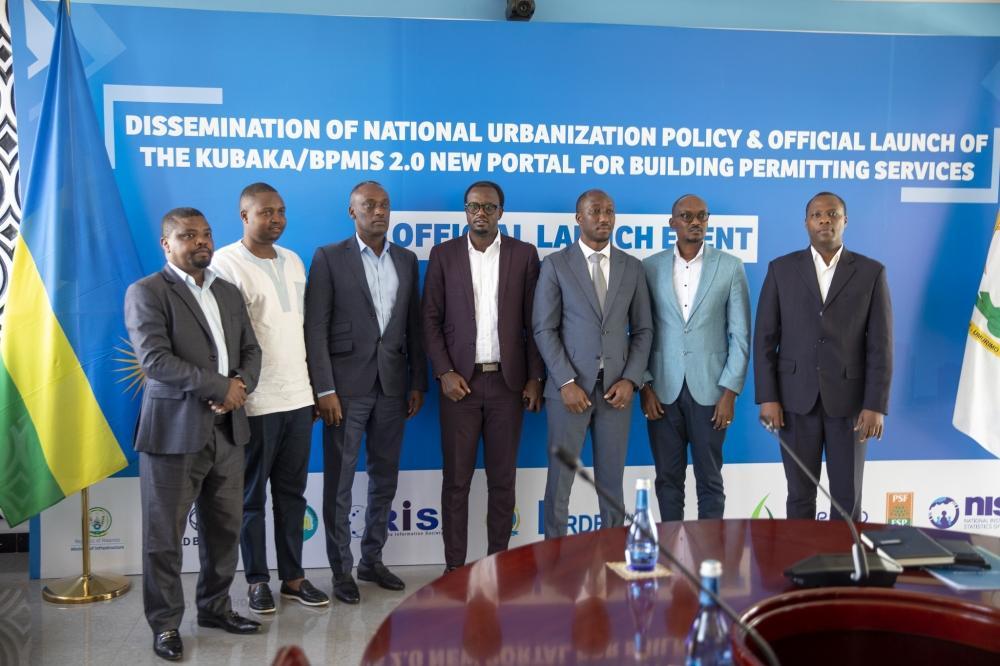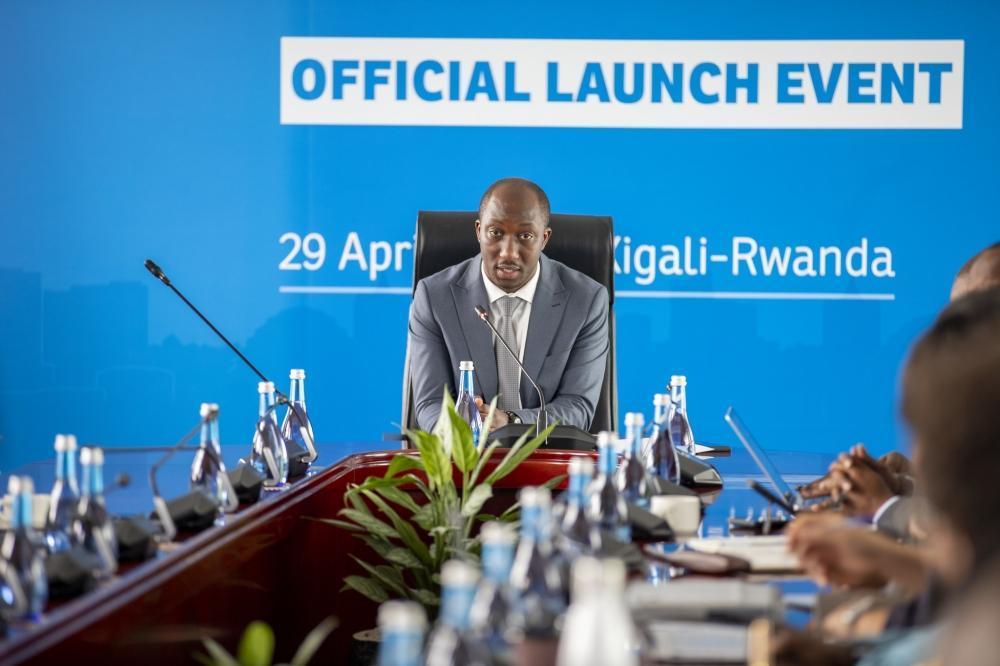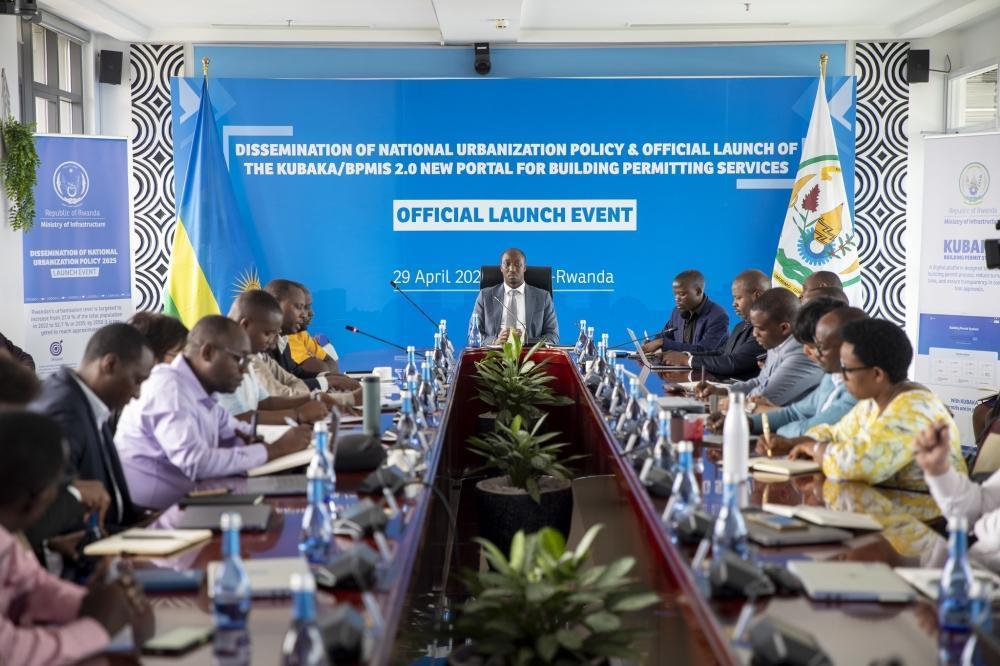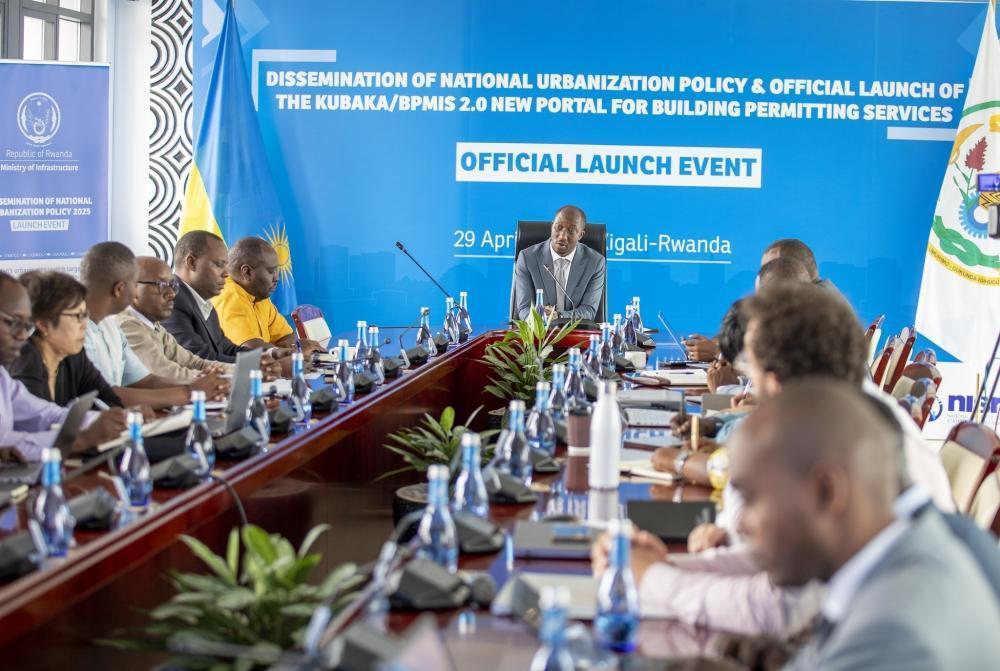Africa-Press – Rwanda. Through the Ministry of Infrastructure (MININFRA), Rwanda has officially launched the dissemination of its revised 2025 National Urbanisation Policy (NUP), alongside the KUBAKA (BPMIS 2.0) portal, the new and enhanced platform for online building permitting services. The upgraded platform is designed to streamline access to the building permitting services through a zero-trip approach, promote transparent, secure, and efficient permitting services, and enhance the user experience.
The official launch event took place on Tuesday, April 29, at the Ministry of Infrastructure (MININFRA) headquarters. It brought together officials and representatives from central and local government institutions, development partners, the private sector, financial institutions, professional bodies, civil society, and academic and research institutions.
Jimmy Gasore, Minister of Infrastructure, speaks at the launch
KUBAKA Platform
The KUBAKA Platform is the enhanced version of the Building Permit Management Information System (BPMIS) introduced in 2016. It will serve as an essential implementation tool of the 2025 National Urbanisation Policy (NUP) as it aligns with its principles of SMART growth and efficient service delivery and will support well-managed, formal, and coordinated urban growth.
According to Dr. Jimmy Gasore, Minister of Infrastructure, the new version addresses long-standing concerns from users, adding new features for the enhancement of service delivery. With a user-friendly and intuitive interface, KUBAKA allows citizens, landowners, investors, and professionals in the real estate industry to apply for and track in real-time the status of their building permit applications online at kubaka.gov.rw.
This digital platform is designed to enhance transparency, professionalism, speed in the application and processing of building permits, and the user experience, supporting Rwanda’s digital transformation agenda under National Strategy for Transformation 2 (NST2).
Minister Gasore noted that the KUBAKA Platform is aligned with the Government of Rwanda’s commitment to socio-economic transformation by enhancing service delivery through the use and adoption of digital technologies in its citizen-centered governance.
In the past, building permit officers were responsible for determining what was or wasn’t allowed, which created inconsistencies and limited transparency, Dr. Gasore explained. The new KUBAKA Platform is directly integrated and aligned with national master plans and can now automatically validate compliance with master plans.
Rwanda has officially launched the dissemination of its revised 2025 National Urbanisation Policy (NUP), alongside the KUBAKA (BPMIS 2.0) portal. Photos by Craish Bahizi
“The KUBAKA platform provides significant improvements from the former BPMIS, by ensuring that urban growth is coordinated, follows the environmental requirements of master plans, adopts the required density standards, and enables formal construction,” Alphonse Rukaburandekwe, the Director General of Rwanda Housing Authority (RHA), noted.
KUBAKA is built on a new and modern architecture and technologies, based on a streamlined zero trip process for building permit application, which was achieved through integrations with government third-party systems for seamless data sharing and verification. These integrations help to share information and automate document verification (such as land ownership, masterplan checks, and tax clearance) through cross-government systems, thus cutting the time and cost to submit and process applications.
“With the launch of this new KUBAKA platform, we are making the building permit process faster, more transparent, and citizen-centred,” said the Chief Executive Officer of Rwanda Information Society Authority (RISA), Innocent Bagamba Muhizi.
“It is a critical step in modernizing service delivery and promoting smart, climate-resilient urban development across Rwanda.”
The revised National Urbanisation Policy
Adopted by the Cabinet on February 10, 2025, the revised National Urbanisation Policy (NUP) updates Rwanda’s 2015 urbanization policy to align with Vision 2050 and the National Strategy for Transformation 2 (NST2).
Minister Gasore emphasised that the new policy builds on a decade of achievements of the first urbanisation policy and aims to tackle persistent urban challenges, including informal growth, climate change and disaster risk, and uneven development between Kigali and satellite and secondary cities.
The government plans to have at least 70 per cent of the population living in urban areas by 2050. Explaining the revised urbanisation policy, Gasore noted that it highlights plans to expand and develop infrastructure in satellite cities and secondary cities, easing population pressure on Kigali.
“From our current urbanisation level of 27.9 per cent, we target to reach 52.7 per cent by 2035, and we will reach 70 per cent by 2050,” Gasore noted.
Dr Jack Ngarambe, Director General in Charge of Urbanisation, Human Settlements and Housing Development at MININFRA, noted that while the 2015 policy achieved significant milestones, such as the development of master plans and urban instruments, the implementation of infrastructure projects, and the use of ICT tools for service delivery, some gaps needed addressing.
The new policy also aims to solve challenges identified from the 2015 NUP, including insufficient budget for implementation, especially limited own-source revenues from districts, limited urban planning capacity in local government entities, and limited access to urbanisation-related data.
Ngarambe noted that the earlier policy was developed under Vision 2020 and needed to be updated for Vision 2050. The new policy is built on four pillars: coordination, densification, liveability, and economic growth. Each pillar presents objectives associated with specific policy actions.
“For coordination, for instance, the aim is to promote inter- and intra-institutional engagements across the government, private sector, and civil society, and focus mainly on cooperation and budget alignment,” Ngarambe said, emphasising that this would be essential in ensuring stakeholders have complementary efforts and maintain resource efficiency.
He added that a policy action to increase coordination in government entities is the establishment of City Management Offices. He underscored that one reason the City of Kigali outperforms other cities is thanks to its City Management Office, which ensures all stakeholders are involved in the city’s development. He emphasised that the goal is to have the same city management offices across the country, starting in districts with satellite and secondary cities.
He also highlighted the vision, mission, and goals of the new national urbanisation policy.
“For the updated policy, the vision is to achieve a balanced spatial development of sustainable and inclusive human settlements throughout Rwanda,” Ngarambe said, noting that the mission is to create sustainable and liveable urban environments that promote social equity and environmental stewardship.
“The goal is to accelerate rates of urbanisation and, in doing so, create hubs of inclusive and green growth through well-managed cities, well-coordinated spatial development, and resilient urban infrastructure.”
For More News And Analysis About Rwanda Follow Africa-Press









